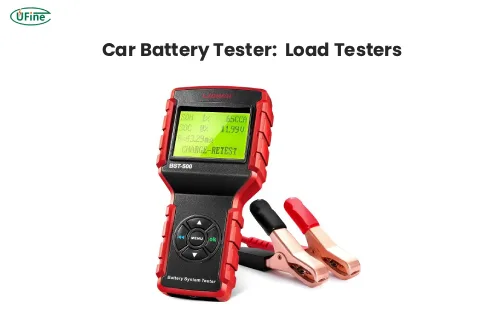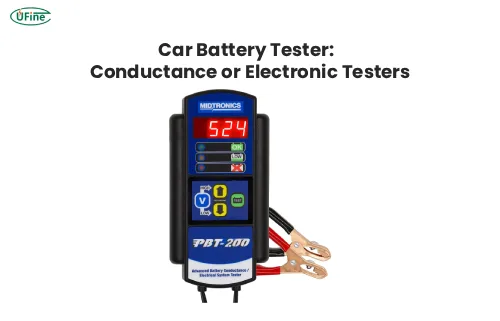
- Part 1. What types of car battery testers are there?
- Part 2. How do battery testers actually measure battery health?
- Part 3. How accurate are car battery testers?
- Part 4. When do battery testers give misleading results?
- Part 5. Are expensive battery testers worth the money?
- Part 6. What are the best practices for using a car battery tester?
- Part 7. What can battery testers not tell you?
- Part 8. Should you test your battery yourself or visit a workshop?
- Part 9. How often should you test your car battery?
- Part 10. Should you buy a car battery tester? What to look for
- Part 11. So, do car battery testers really work?
- Part 12. Final thoughts
When your car struggles to start or your headlights dim unexpectedly, the first thing that comes to mind is the battery. Many car owners today use a car battery tester to check the condition of their battery — but do these devices really work?
The short answer: Yes, most modern car battery testers do work — but how accurately they work depends on the type of tester, how you use it, and the condition of the battery itself. Let’s take a closer look at how they function, their reliability, and what you should know before trusting the results.
Part 1. What types of car battery testers are there?
Car battery testers come in several forms, each with different levels of accuracy and purpose.
1 Voltage Testers (Basic Multimeters)
These are the simplest tools. They measure only the open-circuit voltage of a battery (for example, 12.6V for a fully charged lead-acid battery). While easy to use, they don’t provide a full picture of a battery’s health, because voltage alone doesn’t reveal how the battery performs under load.
2 Load Testers (Carbon-Pile Testers)
Load testers simulate the stress your battery faces when starting an engine. They apply a temporary load and measure voltage drop. If voltage drops too quickly, it indicates a weak battery. These testers are reliable but require experience and should be used carefully, as applying too much load can damage the battery.
3 Conductance or Electronic Testers
These are the most popular car battery testers sold today. They measure the internal resistance and estimate the battery’s Cold Cranking Amps (CCA). Conductance testers are quick, safe, and compact — ideal for workshops and home users. However, they estimate performance mathematically rather than by physically stressing the battery.
4 Advanced EIS (Electrochemical Impedance Spectroscopy) Testers
Professional garages and battery manufacturers use these. They analyze multiple frequency responses to give the most accurate battery health data, including state of charge (SOC) and state of health (SOH). They are expensive but very precise.
Comparison Table: Types of Car Battery Testers
| Type | Measures | Accuracy | Safety | User Level | Best For |
|---|---|---|---|---|---|
| Voltage Tester | Voltage only | Low | Very safe | Beginner | Quick charge checks |
| Load Tester | Voltage under load | High (manual) | Moderate risk | Intermediate | Diagnosing weak batteries |
| Conductance Tester | Internal resistance, CCA | High | Very safe | All users | Regular car maintenance |
| EIS Tester | Full impedance, SOC, SOH | Very high | Safe | Professional | Workshops and labs |
Part 2. How do battery testers actually measure battery health?
A car battery’s health depends on its ability to deliver current under load, not just how much voltage it holds at rest.
Battery testers typically measure:
- Voltage – indicates state of charge.
- Internal resistance (mΩ) – higher resistance means aging or sulfation.
- Cold Cranking Amps (CCA) – how much current the battery can deliver in cold conditions.
- Conductance – how easily current flows through the battery plates.
By analyzing these values, testers estimate whether your battery can still perform properly. For instance, a battery that reads 12.4V but shows high internal resistance is near failure, even if the voltage seems okay.
Part 3. How accurate are car battery testers?
In controlled conditions, most car battery testers are 80–95% accurate in determining a battery’s health. Professional testers, especially those using impedance or EIS technology, can approach laboratory-grade accuracy.
However, the key phrase here is controlled conditions. Real-world factors — temperature, charge level, and battery chemistry — can affect readings. A battery that’s partially discharged may appear “bad,” even though a full charge could restore it.
For example:
- A surface-charged battery (just after charging) might falsely test as “good.”
- A cold battery may show lower voltage and appear “weak,” even if it performs fine at room temperature.
- A sulfated battery may pass a conductance test but fail under actual engine load.
That’s why understanding your tester’s limits is as important as the reading itself.
Part 4. When do battery testers give misleading results?
Battery testers can’t always account for every variable. Here are common situations where their results may be inaccurate:
| Situation | Tester Result | Reality |
|---|---|---|
| Battery freshly charged | “Good” | Surface charge can mask true condition |
| Very cold temperature | “Replace” | May recover when warmed up |
| Low charge (<12.2V) | “Bad” | Just needs recharging |
| Wrong CCA input | “Good” | May not meet true starting demand |
| Sulfated battery | “Good” | May fail suddenly under load |
Tip: Always test a fully charged battery that has rested at least 30 minutes after charging. This allows surface charge to dissipate and provides more accurate data.
Part 5. Are expensive battery testers worth the money?
It depends on your use case.
| User Type | Recommended Tester | Why |
|---|---|---|
| Everyday car owner | Conductance tester (mid-range) | Easy to use, fast results, no risk of damage |
| DIY enthusiast | Load tester + multimeter | More diagnostic control, better understanding |
| Professional mechanic | EIS/Advanced conductance tester | Provides detailed health reports for customers |
Cheaper testers (under $30) may only check voltage, which is not sufficient for real diagnosis. Mid-range models ($50–150) usually give accurate CCA and internal resistance readings. High-end models used in workshops ($300+) can store data, print reports, and work with AGM, GEL, and LiFePO₄ batteries.
AGM Battery vs Gel Battery: A Detailed Comparison
For professionals, the investment pays off because accuracy reduces misdiagnosis. But for home use, a mid-range digital conductance tester is usually more than enough.
Part 6. What are the best practices for using a car battery tester?
Even the most advanced tester can fail if used incorrectly. To get trustworthy results, follow these best practices:
- Fully charge the battery before testing.
- Let the battery rest 20–30 minutes after charging.
- Clean the terminals to remove corrosion or dirt.
- Input the correct specs (battery type, rated CCA, etc.).
- Avoid testing in extreme temperatures.
- Take multiple readings if results are borderline.
- Recheck after driving or charging if you suspect surface charge effects.
Using your tester as part of a routine maintenance schedule — for example, once every three months — helps you track gradual performance loss rather than waiting for sudden failure.
Part 7. What can battery testers not tell you?
Even the best car battery testers have limits. They cannot:
- Predict remaining lifespan precisely.
- Detect deep internal sulfation if the conductance path remains partially open.
- Measure actual capacity (Ah) without a full discharge test.
- Diagnose charging system faults (alternator, regulator, wiring).
That’s why if your car shows electrical issues despite a “good” battery test, it’s wise to test the charging and starting systems as well.
In some cases, a full load or capacity test remains the only way to know the real health of an aging battery.
Part 8. Should you test your battery yourself or visit a workshop?
Both options have advantages.
DIY Testing
- Pros: Inexpensive, instant results, can test anytime.
- Cons: May misinterpret results or lack tools for further diagnosis.
Professional Testing
- Pros: Accurate readings with calibrated tools, technician insight, printouts for warranty claims.
- Cons: Costs more, less convenient.
If your car battery is relatively new (under two years) and you simply want peace of mind, a home tester works well. But for older batteries, or if your car struggles to start, getting a professional diagnostic is more reliable.
Part 9. How often should you test your car battery?
A car battery typically lasts 3–5 years depending on climate and driving habits. Testing it every 3–6 months helps catch early signs of weakness, especially before winter or long trips.
Warning signs that it’s time to test include:
- Slow cranking or dim headlights.
- Dashboard warning lights.
- A battery over three years old.
- Long periods of vehicle inactivity.
By testing regularly, you can avoid the inconvenience of being stranded due to a sudden battery failure.
Part 10. Should you buy a car battery tester? What to look for
If you perform your own maintenance or drive frequently, owning a car battery tester is a smart investment.
When shopping for one, look for these features:
- Wide compatibility: Supports standard lead-acid, AGM, GEL, and lithium batteries.
- CCA and internal resistance measurement: Gives a full picture of health.
- Reverse polarity protection: Prevents damage if connected incorrectly.
- Temperature compensation: Ensures accurate readings in different environments.
- Display and storage: Shows results clearly and keeps history for comparison.
Popular brands in the mid-range market often offer reliable accuracy and durability for everyday users.
Part 11. So, do car battery testers really work?
In conclusion, yes — car battery testers do work, and they are extremely helpful for monitoring battery health, saving time, and preventing roadside surprises. However, their reliability depends on:
- The type of tester (conductance and impedance models are best).
- Proper use and correct input settings.
- The state of the battery during testing (fully charged and rested).
Used correctly, a good car battery tester provides an excellent early-warning system, helping you replace your battery before it fails.
Part 12. Final thoughts
Can a tester detect a bad cell?
Most conductance testers can identify imbalance between cells indirectly through high internal resistance or abnormal voltage drops, but only a full load test confirms a dead cell.
Is voltage alone enough to judge battery health?
No. A battery can show normal voltage yet fail under load. That’s why conductance or load testing is more reliable.
How often should I test my car battery?
At least every six months, or before a major trip. More frequent testing is wise if you drive short distances or live in extreme temperatures.
Can I use a tester on an AGM or lithium battery?
Yes, but only if the tester supports those chemistries. Using the wrong mode can give false results.
Related Tags:
More Articles

100AH Golf Cart Battery Life: How Long Can It Last?
Wondering about your 100AH golf cart battery's lifespan? Find out what affects its longevity and how to keep it running longer. Read now!
What Is a Battery Disconnect and Why You Should Use One?
Learn how a battery disconnect switch prevents power loss, improves safety, and extends battery life for cars, RVs, boats, and solar systems.
Why Do Batteries Get Sulfated and How Can You Prevent It?
Learn what causes sulfated car batteries, how to fix them with desulfation charging, and expert tips to prevent future battery damage and failure.
How Long Does a 22NF Battery Last and What Does It Mean?
Learn what 22NF means, its size, specs, types, and lifespan. Find the best 22NF battery for your vehicle or equipment with expert guidance.
The Complete Guide to 4D Batteries: Size, Specs, Price & Lifespan
Learn what a 4D battery is, how it works, specs, size, and price. Compare AGM vs lithium 4D batteries and find where to buy them safely.







